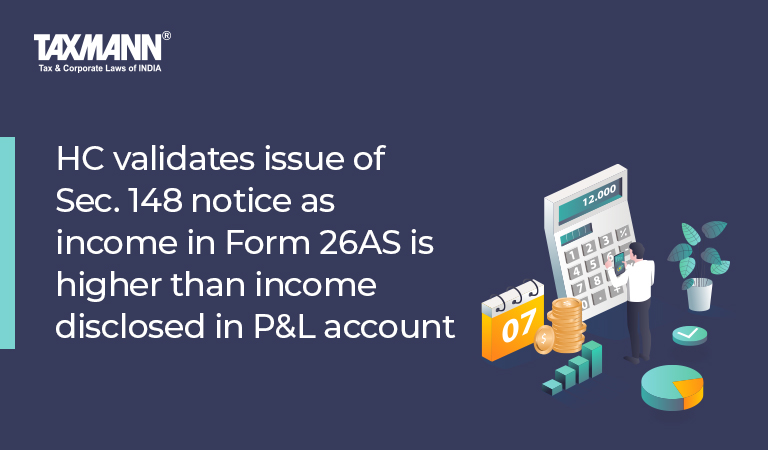HC validates issue of Sec. 148 notice as income in Form 26AS is higher than income disclosed in P&L account
- News|Blog|Income Tax|
- 3 Min Read
- By Taxmann
- |
- Last Updated on 29 July, 2022
Case Details: Distributors India C and F v. Union of India - [2022] 140 taxmann.com 338 (Allahabad)
Judiciary and Counsel Details
-
- Devendra Kumar Upadhyaya And Subhash Vidyarthi, JJ.
- Shailesh Verma and Swati Upadhyay for the Petitioner.
- Manish Mishra A.S.G.I. for the Respondent.
Facts of the Case
In this case, the assessee was working as a C&F agent for a number of companies, which outsourced their logistics and distribution operations to it. In the return of income, the assessee declared its gross receipts lower than the receipts reflected in Form 26AS. The Assessing Officer issued a notice under section 148 and asked the assessee to explain the discrepancy.
The assessee submitted its reply stating that as part of its service, it had incurred several expenses on behalf of the companies and at the time of reimbursement of such expenses, some of the companies deducted TDS thereon. However, such reimbursements were not an income of the assessee and, therefore, these receipts were not reflected in its income. Further, the assessee raised an objection regarding maintainability of the notice under section 148 on ground that reassessment proceedings were initiated on the basis of a change of opinion, which is not permissible in law.
The NFAC rejected the objection raised by assessee and passed an order that the income reflected in Form 26AS was higher than the income shown in the P&L account, and the difference in receipts was not explained by the assessee with any documentary evidence. Thus, the assessee did not make full and true disclosure of all the material facts which resulted in escapement of income. Further, it was found that the Assessing Officer had recorded his reason to believe that the assessee had received payments under sections 194I and 194J also, but it had not shown the said receipts in his profit and loss account and had not given any explanation for the same.
High Court Held
The assessee furnished instant Writ petition to the High Court and the High Court held that the notice under section 148 had been issued by the Assessing Officer after conducting due investigation and going through the income tax return and other related documents of the assessee and after recording a reason to believe that the assessee had not truly and fully disclosed all the material facts because of which income has escaped assessment.
The Court is satisfied that there was prima facie material available on record before the Assessing Officer for issuing a notice under section 148. The notice issued under section 148 as well as all the proceedings undertaken in consequence of the notice including the order passed by the NFAC rejecting the assessee’s objections against the notice did not suffer from any such illegality as to warrant interference.
List of Cases Reviewed
-
- Raymond Woollen Mills Ltd. v. ITO [1999] 236 ITR 34 (SC)
- Phool Chand Bajrang Lal v. ITO [1993] 69 Taxman 627/203 ITR 456 (SC)
- Sai Krishna (P.) Ltd. v. ITO [1996] 9 SCC 534 (para 35) followed.
List of Cases Referred to
-
- Raymond Woollen Mills Ltd. v. ITO [1999] 236 ITR 34 (SC) (para 15)
- Aventis Pharma Ltd. v. Asstt. CIT [2010] 323 ITR 570 (Bom.) (para 23)
- Arun Gupta v. Union of India [2016] 66 taxmann.com 348/[2015] 371 ITR 394 (All.) (para 24)
- Phool Chand Bajrang Lal v. ITO [1993] 69 Taxman 627/203 ITR 456 (SC) (para 27)
- Sri Krishna (P.) Ltd. v. ITO [1996] 9 SCC 534 (para 28)
- CIT v. Techspan India (P.) Ltd. [2018] 92 taxmann.com 361/255 Taxman 152/404 ITR 10 (SC) (para 30)
- United Electrical Co. (P.) Ltd. v. CIT [2002] 125 Taxman 775/258 ITR 317 (Delhi) (para 32).
Disclaimer: The content/information published on the website is only for general information of the user and shall not be construed as legal advice. While the Taxmann has exercised reasonable efforts to ensure the veracity of information/content published, Taxmann shall be under no liability in any manner whatsoever for incorrect information, if any.

Taxmann Publications has a dedicated in-house Research & Editorial Team. This team consists of a team of Chartered Accountants, Company Secretaries, and Lawyers. This team works under the guidance and supervision of editor-in-chief Mr Rakesh Bhargava.
The Research and Editorial Team is responsible for developing reliable and accurate content for the readers. The team follows the six-sigma approach to achieve the benchmark of zero error in its publications and research platforms. The team ensures that the following publication guidelines are thoroughly followed while developing the content:
- The statutory material is obtained only from the authorized and reliable sources
- All the latest developments in the judicial and legislative fields are covered
- Prepare the analytical write-ups on current, controversial, and important issues to help the readers to understand the concept and its implications
- Every content published by Taxmann is complete, accurate and lucid
- All evidence-based statements are supported with proper reference to Section, Circular No., Notification No. or citations
- The golden rules of grammar, style and consistency are thoroughly followed
- Font and size that’s easy to read and remain consistent across all imprint and digital publications are applied








 CA | CS | CMA
CA | CS | CMA


